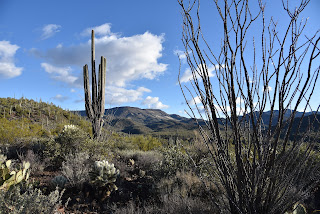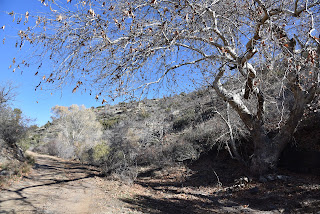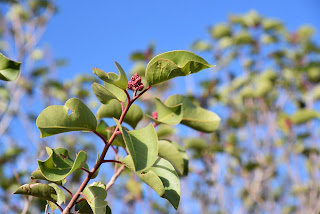TORTUGA-SPUR CROSS LOOP
 |
| The pachyderm profile of Elephant Mountain |
A quick loop hike in Spur Cross Ranch Conservation Area north of the town of Cave Creek yields a heart-stirring trip through canyons, saguaro-fleeced slopes and a rare desert waterway, all backed with outstanding mountain views.
 |
| Saguaros cling to slopes below the CaveCreek Mountains |
The short, but steadily challenging hike ties together two of the Maricopa County Regional Park’s trails into one stunningly tour of Sonoran Desert diversity.
From the trailhead, begin by hiking northwest (go right and downhill) on the Spur Cross Trail which is also part of the Valley-circling Maricopa Trail. In less than a half-mile, the trail crosses Cave Creek.
 |
| Skull Mesa viewed from the Tortuga Trail |
Fed by storms and snowmelt, water runs sporadically through the rocky channel and is usually at its height during the winter and spring months. A few yards past the creek crossing, continue north on Spur Cross from the Metate trail junction keeping an eye out for the foundations of the defunct Spur Cross dude ranch crumbling among cholla and creosote shrubs.
 |
| Sun-lit saguaros glow on the Tortuga trail |
Over the next 0.6-mile, the route climbs easily, opening views of the creek gorge below and the flat-topped tableland of Skull Mesa and Sugarloaf Mountain to the northeast. One mile in, pick up the Tortuga Trail which signals the beginning of a steady ascent on a degraded dirt track that hangs on the cusp of a ravine flush with acres of saguaros, prickly pear, ocotillo and cholla that glow in thorny halos when backlight by the sun.
 |
| A crossing of Cave Creek comes early in the hike |
The 1.1-mile uphill section is heralded by a sign warning of primitive conditions ahead.
 |
| The as-advertised primitive trail |
While the route is indeed rough, it’s not too difficult to follow. Soon, more vistas open to the south.
 |
| Benches for viewing at the top of the loop |
Look for Cave Creek classic, Black Mountain, the Cave Creek Mountains, the long profile of the McDowell Mountains and singular Pinnacle Peak on the horizon.
 |
| Sugarloaf Mountain (left) seen from Tortuga trail |
 |
| This hike uses the Spur Cross & Tortuga trails |
The circuit tops out at the Elephant Mountain trail junction where the best glimpses of the 3,926-foot massif’s pachyderm profile command attention. A couple of benches overlooking the mark the spot where the Tortuga trail begins a 0.6-mile downhill trek toward the leafy cut of the Jewel of the Creek Preserve.
 |
| Tortuga trail is rough but not hard to follow |
To finish up this loop hike, head left at the Dragonfly trail junction and follow the Spur Cross trail as it switchbacks through a deep gully on its way back to the trailhead.
LENGTH: 5.3 miles
RATING: moderate
ELEVATION: 2,340 -2,615 feet
GETTING THERE:
44000 N. Spur Cross Road, Cave Creek
From Loop 101 in Phoenix, take Cave Creek Road north to Spur Cross Road (on the left just as you enter the downtown area) and go 4.5 miles north to the parking area.
FEE: $3 per person daily fee. Bring exact change.
INFO:
https://www.maricopacountyparks.net/park-locator/spur-cross-ranch-conservation-area/



















